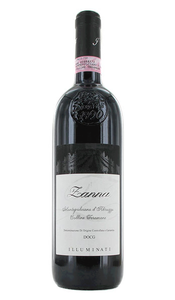|
|
 |

Illuminati, Montepulciano d’Abruzzo Colline Teramane DOCG (Abruzzo, Italy) “Zanna” 2010 (Montcalm Wine Importers, $40): In 2013, white wine production in Italy continued to gain on red wine, 53 percent for white to only 47 percent for red and rosé. (Not so long ago, red wine accounted for two-thirds of production.) The phenomenal success of Pinot Grigio and Prosecco are likely reasons for the spurt in whites but, with total production decreasing, what accounts for the  corresponding drop in red wines? In pondering this question, I wondered whether Montepulciano d’Abruzzo was part of the answer, but hoped it wasn’t, because this wine from central Italy has long been one of Italy’s most compelling red wine values. corresponding drop in red wines? In pondering this question, I wondered whether Montepulciano d’Abruzzo was part of the answer, but hoped it wasn’t, because this wine from central Italy has long been one of Italy’s most compelling red wine values.
Abruzzo is the region that lies along the Adriatic Sea south of the Marche region, and across the Appenine Mountains from Rome. Abruzzo’s red wines derive mainly from the Montepulciano grape variety and its white wines, from Trebbiano. It’s a warm region but sea influences and interior hills create climate and soil diversity. In the 1970s and 1980s, Montepulciano d’Abruzzo and Trebbiano d’Abruzzo enjoyed brisk sales in the U.S. as reliable, inexpensive house wines in Italian restaurants. Over the past 15 years, the region has upgraded its wines’ image through winery investment, recognition of superior sub-zones for the DOC Montepulciano d’Abruzzo, and establishment of a DOCG-level wine, Montepulciano d’Abruzzo Colline Teramane (from the hills around Teramo, in the northern part of the region).
One of Abruzzo’s most illustrious wineries is Illuminati, a family company founded 120 years ago. Illuminati now owns about 320 acres of vineyards in the northernmost part of the region, and produces more than 80 thousand cases of wine annually. Illuminati makes seven red wines, all but one of them entirely from the Montepulciano grape but grown in different vineyards or separate DOC zones.
Among Illuminati’s reds, “Riparossa” Montepulciano d’Abruzzo DOC is the entry-level wine ($13) and “Zanna” Monteplciano d’Abruzzo Colline Teramane Riserva DOCG is the flagship wine ($40). The 2013 Riparossa shows all the richness of ripe black-cherry fruit that makes Montepulciano d’Abruzzo such a likeable wine, along with notes of tea and spice. Tannins are grainy but not assertive, adding an edge of character and freshness to the flavorful fruitiness of this medium-bodied red. This is an all-purpose red that will suit most wine drinkers and most foods.
The flagship Zanna is produced only in the best vintages. Besides coming from old vines (45 years average age) of a single vineyard called Zanna, the wine ages for four years at the winery compared to only one year for the Riparossa. The 2010 Zanna has pronounced aromas of blackberry, spice and flowers, with mineral notes joining those impressions on the palate. It is full-bodied with impressively rich and smooth texture and soft tannins. For a wine so laden with fruitiness, it has beautiful complexity and holds your interest as only great wines can.
One aspect of the Zanna that fascinates me is that the grapes come mainly from vines planted in Abruzzo’s traditional, overhead-trellis system, known as “pergola.” Only 1100 vines occupy each hectare of vineyard (about 450 vines per acre), compared to modern vertical trellis systems of 5000 vines per hectare (about 2000 per acre). The older system encourages large crops, but the winery reduces the crop through green harvest, and has also begun converting the vineyard to vertical trellises. The quality of the Zanna to me validates the much-maligned overhead trellis, at least in this instance.
Another interesting aspect of this wine is that ages not in small barrels of French oak but in 25-hectoliter casks (more than ten times larger than a barrel) of Slavonian oak; the casks are two and three years old, and the wine spends two years aging there, followed by another two years in bottle before release. To my taste, any oakiness that the casks might confer is so well integrated in the wine as to be unnoticeable.
Illuminati’s Zanna is a celebrated wine that perennially wins the exalted “Tre Bicchiere” status from famed Italian wine and food magazine Gambero Rosso.
92 Points
|
 |
|